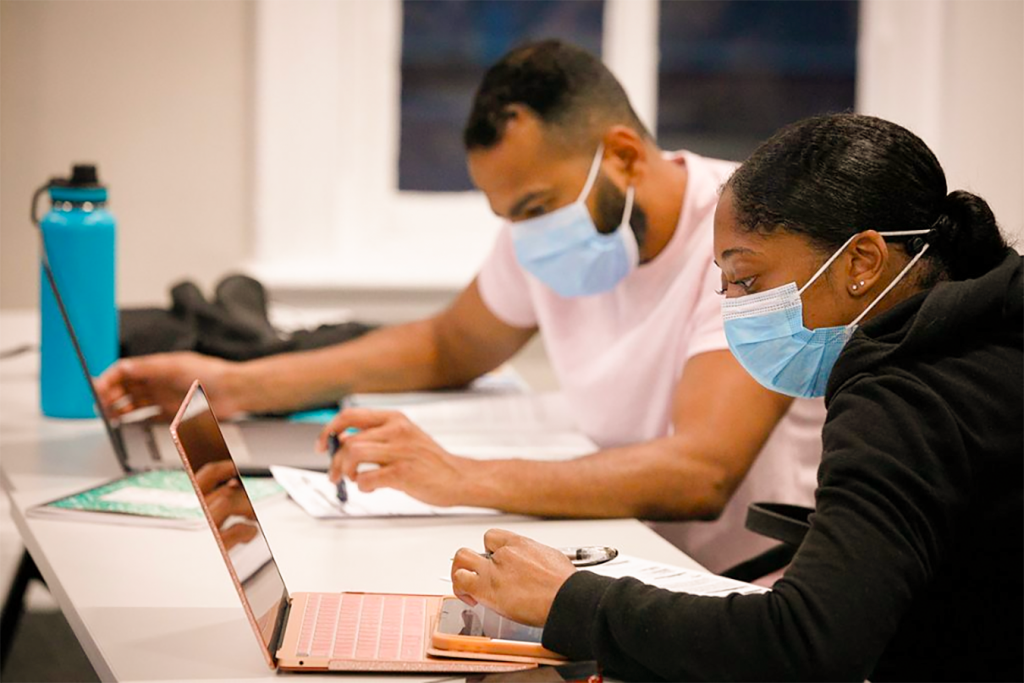How to Become a Nurse Midwife in 5 Steps
Each blog post is dated and contains accurate information as of that date. Certain information may have changed since the blog post publication date. If you would like to confirm the current accuracy of blog information, please visit our ABSN overview page or contact admissions at (844) 347-2503.
Understanding how to become a nurse midwife helps you plan your nursing education. Aspiring nurse midwives should earn a BS in Nursing and pass the NCLEX to become licensed registered nurses. After gaining clinical experience, the next steps are to earn a graduate degree and pass the certification exam.

The nursing career is full of opportunities to find the specialty that best suits your unique skills and interests. If you are considering becoming a nurse and are interested in working with expecting mothers and their newborns, then nurse midwifery may be right for you. As you explore the many nursing paths available, knowing how to become a nurse midwife can help you decide.
Nurse midwives play an essential role in the healthcare team. Skilled and knowledgeable in women’s and newborn health, nurse midwives support mothers with family planning, gynecological health, pregnancy, and delivery.
Becoming a nurse midwife requires significant education. Fortunately, the University of Mount Saint Vincent has a long history of developing highly skilled and compassionate nurses, ready to pursue a variety of nursing specialties—including nurse-midwifery.
If you have already earned a bachelor’s degree and are established in your career but wish to pivot toward nursing, the Mount can help you achieve your goals. Our Accelerated Bachelor of Science in Nursing (ABSN) program helps fast-track your nursing education so you can graduate sooner with a Bachelor of Science (BS) in Nursing.
Below, we will discuss how to become a nurse midwife so you can plan your nursing education accordingly.
What is a Nurse Midwife?
Nurse midwives are advanced practice registered nurses (APRNs) who provide gynecological care and family planning to patients ranging from adolescents to menopausal. They focus on reproductive health and childbirth, caring for their patients before, during, and after labor.
Nurse midwives are highly educated and must maintain certification, setting them apart from regular midwives. Regular midwives provide care during labor and delivery, while nurse midwives are registered nurses (RNs) with a larger scope of practice.
They can provide a wide range of medical care to mothers and newborn babies and work in various medical environments, such as hospitals, universities, and private practices, to name a few.

What Does a Midwife Do?
The nurse midwife role is similar to that of OB/GYNs, except OB/GYNs can provide more advanced care, such as Cesarean section surgery. Nurse midwives focus on the health of the mother and child before delivery and after.
What does a midwife do? While the scope of practice may vary from state to state, nurse midwives are typically responsible for the following responsibilities, among others:
- Pre- and postnatal care
- Pregnancy confirmation and dating
- Labor and delivery (e.g., labor progress assessment and complication and pain management)
- Patient education (e.g., family planning, infant care, breastfeeding)
- Preventive health screenings and tests
- Gynecological disorder diagnosis and treatment
Nurse Midwife Education Requirements
You may have heard of Certified Nurse Midwives (CNM) and Certified Midwives (CM) and thought of them as the same; however, they are not interchangeable. CNMs and CMs have different education requirements.
A CM must complete science and health courses in an accredited bachelor’s program, where they receive health skills training. After earning a bachelor’s degree in a relevant field, CMs earn a graduate degree from an accredited midwife program.
On the other hand, CNMs must first earn a BS in Nursing and their nursing license before entering an accredited nurse-midwifery program. Many nurse midwife programs also require students to have a few years of clinical experience before enrolling.
Education aside, the main difference between CMs and CNMs is state regulation. As you determine which path is best for you, remember that CMs are legally recognized to practice in a limited number of states, while CNMs are recognized in every state.

How to Become a Certified Nurse Midwife
Becoming a nurse midwife takes several years; however, you can expedite the process if you have a non-nursing bachelor’s degree. Below is an exploration of how to become a certified nurse midwife.
1. Earn Your BS in Nursing
The first step to becoming a certified nurse midwife is enrolling in nursing school and earning your BS in Nursing. While a BS in Nursing is not the minimum credential for nurses, it is for certified nurse midwives. CNMs must eventually enroll in a graduate program, which requires all students to have at least a bachelor’s degree to be eligible.
Most traditional BS in Nursing programs require four years to complete; however, accelerated BS in Nursing programs are available to those who meet eligibility requirements.
At the Mount, students can earn their BS in Nursing in as few as 16 months. The ABSN curriculum includes nursing coursework, simulation and skills labs, and clinical rotations, all designed to provide a solid nursing education that prepares you to pass the National Council Licensure Examination for Registered Nurses (NCLEX-RN).
As an ABSN student, you can expect the same high-quality education one would receive from a traditional, four-year BS in Nursing program. Coursework establishes essential nursing concepts, which skills labs reinforce. Students expand on these concepts and develop clinical judgment through simulation labs. Finally, students apply their skills and knowledge in clinical rotations, providing direct patient care under supervision.
2. Pass the NCLEX-RN
Once you earn your bachelor’s degree, you must take the NCLEX-RN, a nationally recognized nursing certification exam. The NCLEX assesses a prospective nurse’s clinical judgment rather than their ability to memorize nursing facts.
Questions include multiple “correct” multiple-choice answers, and test takers must identify the most “appropriate” answer based on the given context.
The NCLEX utilizes computerized adaptive testing (CAT) scoring, which adjusts questions based on your performance. For example, CAT technology reduces the number of “easy” questions for high-performing candidates and vice versa for low-performing candidates. Ultimately, the length of the test depends on how many questions you answer correctly.
The NCLEX features a unique exam style you likely have not experienced before. This is why it’s important to start studying for the NCLEX early. It’s best to consistently review your notes and take NCLEX practice exams throughout nursing school rather than waiting until the weeks leading up to the exam.
On exam day, arrive early after a full night’s rest. Dress comfortably and do not arrive hungry so you are ready to focus for an extended period. Once you pass the NCLEX, you can apply for your nursing license at your local state board of nursing.

The NCLEX can be intimidating, but you can be successful with the right preparation. Read more to learn how to prepare for the NCLEX.
3. Gain Clinical Experience
Now that you’re a newly licensed nurse, it’s time to gain clinical experience. Many graduate degree programs require applicants to have a few years of clinical experience as a registered nurse.
RNs can work in various settings, such as hospitals, long-term care facilities, schools, and private practices. Use this time wisely. Even though you are not working as a nurse midwife yet, this is the time to learn from experienced nurses and develop clinical skills. Nurses are lifelong learners, and their education continues after graduation.
4. Earn a Graduate Degree
The next step is to earn your graduate degree through a certified nurse midwife program accredited by the Accreditation Committee for Midwifery Education (ACME). You can pursue two graduate degree options to become a CNM: Master of Science (MS) in Nursing and Doctor of Nursing Practice (DNP).
Although there has been a recent push for APRNs to earn a DNP over an MS in Nursing, the American College of Nurse-Midwives (ACNM) believes that a DNP should not be the requirement for entry.
Carefully consider which graduate degree suits your goals and needs, then choose the program that best helps you meet them.
5. Pass the Nurse Midwife Certification Exam
The final step in becoming a certified nurse midwife is to take the national certification exam presented by the American Midwifery Certification Board (AMCB). Much like the NCLEX, the midwifery certification exam assesses a candidate’s clinical decision-making and knowledge of physical examination findings, lab values, physiology, and more.
The test format is multiple-choice and tests candidates in all clinical areas associated with midwifery. Preparation for this exam should begin as soon as possible so you are not overwhelmed as the test date nears.

Once you pass the exam, you can apply for your nurse midwife certification and begin practicing as a certified nurse midwife.
Nurse Midwife Salary and Career Outlook
The nationwide nursing shortage affects not only registered nurses but also nurse midwives. As a result, there are many job openings for certified nurse midwives as the need continues to grow and supply lags behind demand. The projected growth for nurse midwives in New York is 16% between 2020 and 2030, much higher than the national average of 6%.
The nurse midwife salary is also lucrative. In New York, nurse midwives make a median salary of $127,360 in 2022, higher than the average for the U.S.
Picking the right nursing school for you can be challenging. Read more to learn what an ABSN is and whether it’s right for you.

Take the First Step Towards Becoming a Nurse Midwife
Now that you know how to become a nurse midwife, the next step is to start your nursing education. At the Mount, our ABSN program prepares you for any nursing specialty by establishing a versatile nursing foundation on which you can build your career.
You may be eligible to apply to our ABSN program if you have a non-nursing bachelor's degree. Contact an admission counselor today to learn more about our ABSN program and determine whether it’s right for you.
